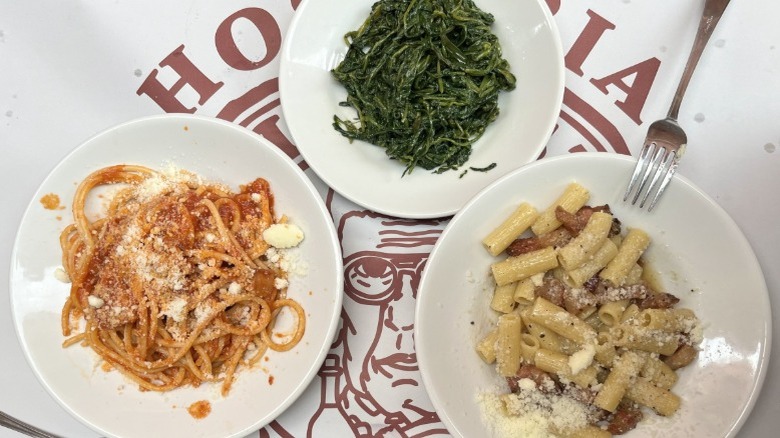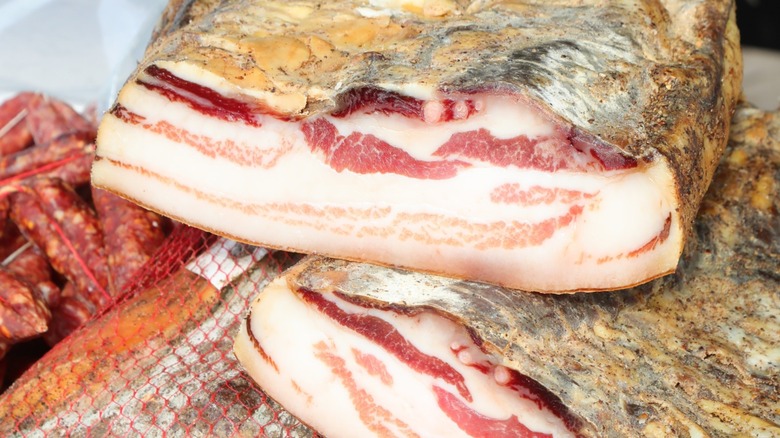Italy's Umbria And Lazio Regions Are Home To A Unique Deli Meat That's Tender, Flavorful, And Takes Three Months To Cure
Guanciale and carbonara. Guanciale and amatriciana. Guanciale and gricia. Like Romeo and Juliet, Dolce and Gabbana, and Maradona and Naples, the Italian pairing of this tender and flavorful deli meat and these pasta dishes that rule the Roman epicurean empire is one of the country's uncompromisable culinary commandments. Guanciale is an integral ingredient in cucina povera ("kitchen of the poor"), the traditional peasant philosophy of nose-to-tail, fields-to-table, no-wastage, full-flavor home cooking historically born out of necessity but also a sumptuously exuberant fact and facet of life in Italian regions like Lazio and Umbria, where agricultural culture reigns.
The rich would typically turn their noses at less noble cuts of meat like the jowl ("guancia"), leaving these scraps for commoners to season, skin and all, with sea salt, pepper, and spices like thyme, fennel, and garlic. Air-drying it for three months produces a luxuriantly fatty, unique cured pork that cloaks the palate with velvety umami, anointing dishes and ingredients with piquant essences and powerful fragrances that pack a bigger flavor punch than pancetta, the other quintessential Italian cured meat, which comes from the pig's belly.
The larger-than-life attribute of this deli meat went a long way on humble tables, where a simple smattering of guanciale could infuse pots of sauces, soups, and stews, hearty vittles for life in the Latium and Umbrian mountains and farms. It's also versatile enough to top pizza, add an extra crunch to salads, or even savor on its own as a snack — pair it with some Chianti, sangiovese, or aglianico wine. The authentic central Italian repast, with its courses of terrain simmered in history and pastoral practices percolating into complex gastronomic nuances, deserves all the time to relish, which is why tourists should never expect a quick dinner during trips to the Bel Paese.
In central Italy, guanciale flavors classic dishes with gusto
Some say the saga of Roman sauces began as early as A.D. 5 in the Lazio countryside. A shepherd's ritual of ferrying local ingredients into the wild for making pastas seasoned with pecorino (sheep's cheese) and guanciale while herding flocks would bloom into what we enjoy as gricia today. Fry guanciale bits with onions, tomato paste, and red pepper flakes to create the fiery fountain of sharp and tart amatriciana, originating from 17th-century Amatrice, just like its cheeky companion. And believe it or not, carbonara was born in Rome shortly after World War II, when American G.I.s craved a "spaghetti breakfast" of eggs, bacon, and pasta, which innkeepers hustled up with black market bacon and egg powder. Despite this controversial ancestry, it's a tasty testament to guanciale that carbonara is now the most famous of the holy trinity of Roman pastas — once the cherished lard replaced bacon, the dish became an inextricable fixture of the Eternal City. Slurp these showcases of guanciale gastronomy at the absolute best pasta places Stanley Tucci ate at in Rome.
Guanciale is hailed in other forms in these regions. The Romans celebrate Labor Day on May 1 with fave al guanciale, a dish of fava beans sautéed with guanciale, onions, olive oil, salt, and pepper, splashed with white wine, and Umbria's friccò all'Eugubina stew of guanciale and game is served on Sundays and at Christmas. Everyday eats accentuated include Lazio's pasta e patate and the Umbrian barbazza, an appetizer of this salame fried in strips with sage and sagrantino red wine. To live and breathe guanciale, spend time in an agriturismo where it features prominently in rustic farmhouse cooking, like Hortus Natural Living in Umbria, one of the 12 best farm stays in Italy, according to tourists.

